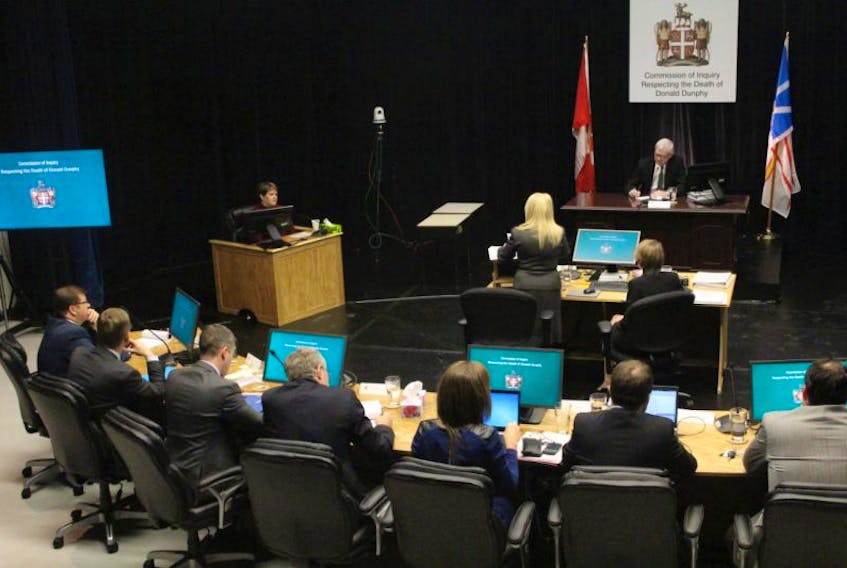Dunphy was shot and killed in his Mitchell’s Brook home on Easter Sunday, 2015, by RNC Const. Joe Smyth, who was assessing a potential threat based on a message Dunphy posted on Twitter directed at then-premier Paul Davis and then-cabinet minister Sandy Collins.
The inquiry first heard from Donna Ivey, a communications staffer in the premier’s office. She saw the critical tweet and forwarded it to Smyth, who was assigned to the premier’s security detail.
Ivey said she didn’t understand what Dunphy was saying, but it was “very strong” language.
In isolation, Dunphy’s tweet appears to be a threat: “won’t mention names this time, 2 prick dead MHAs might have good family members I may hurt.”
Ivey said the part about “2 prick dead MHAs” and potentially hurting family members caused her concern.
But lawyer Erin Breen, who is at the inquiry representing Dunphy’s daughter, Meghan Dunphy, pressed Ivey on this.
Breen argued that when read in context, it was clear Dunphy’s post was no threat at all.
The Twitter exchange began with Collins tweeting that he was driving with Davis and they were listening to “The Sun In Your Eyes” album by musician Sherman Downey.
Dunphy responded with a series of tweets, complaining about MHAs not caring about injured workers and poor people.
Dunphy’s tweets aren’t easy to read, because he uses “u” and “c” to stand in for “you” and “see” and he repeats words and uses confusing grammar.
But stitched together, Dunphy’s message appears to be something like, “Is that why you can’t see problems of seniors and injured workers, the sun is in your eyes? Put on sunglasses and take out the ear plugs, you might see and hear people crying for help, but why would you care about putting in hard time getting that poor man’s MHA pension. I hope there is a God. I think I see him work on two garbage MHAs who laughed at poor people. He got them before they got to enjoy the pension they didn’t deserve. I won’t mention names this time. Two prick dead MHAs might have good family members I may hurt.”
This quotation has been cleaned up and stitched together across several tweets for readability, but Breen argued that to a normal person reading it in context, the final tweet clearly was a reference to two MHAs who died before they were able to collect a pension. In this interpretation, the “good family members I may hurt” refers to potentially embarrassing surviving family members by mentioning names of people who were dead.
Ivey didn’t send the full string of tweets to Smyth; she sent only the final tweet which she deemed to be concerning.
She said she didn’t send the full context because it would have been difficult to copy and paste the whole string of tweets on the Blackberry she was using.
Ivey said she never received any training, and there were no written protocols about when to refer potential threats to the police.
Ivey said she didn’t read it as a threat, just a cause for concern. But Breen brought up a statement she made to RCMP Cpl. Monty Henstridge in the days after the shooting where she said she perceived it as a possible threat to hurt MHAs’ families.
“You were saying, ‘we perceived it as a possible threat,’” Breen said.
Ivey responded, “Well, emotions were running high, I guess, immediately after that. But I would not use the word threat. I don’t know why I used it there.”
Later in the day, the inquiry heard from Tom Mahoney with Workplace NL, who received a call from Smyth on the day of the shooting, and he gave Smyth address information for Dunphy from the Workplace NL files.
Mahoney also argued that Dunphy’s tweet would have warranted a police assessment.
Breen challenged him on that interpretation.
“With the greatest of respect, I think the common person who reads this statement from start to finish can clearly see that Mr. Dunphy is saying that he doesn’t want to speak ill of the dead because they have family members that are still here, who he would hurt their feelings,” she said.
Mahoney said he still would have considered referring the tweet to police based on what Dunphy said.
In another circumstance, though, where Dunphy wrote on Twitter that he hoped all Worplace NL employees die, Mahoney said he didn’t interpret that as a potential threat.
The inquiry continues today, and hearings are expected to go until early March.
The final report by Justice Leo Barry is expected by the end of June.
Dunphy was shot and killed in his Mitchell’s Brook home on Easter Sunday, 2015, by RNC Const. Joe Smyth, who was assessing a potential threat based on a message Dunphy posted on Twitter directed at then-premier Paul Davis and then-cabinet minister Sandy Collins.
The inquiry first heard from Donna Ivey, a communications staffer in the premier’s office. She saw the critical tweet and forwarded it to Smyth, who was assigned to the premier’s security detail.
Ivey said she didn’t understand what Dunphy was saying, but it was “very strong” language.
In isolation, Dunphy’s tweet appears to be a threat: “won’t mention names this time, 2 prick dead MHAs might have good family members I may hurt.”
Ivey said the part about “2 prick dead MHAs” and potentially hurting family members caused her concern.
But lawyer Erin Breen, who is at the inquiry representing Dunphy’s daughter, Meghan Dunphy, pressed Ivey on this.
Breen argued that when read in context, it was clear Dunphy’s post was no threat at all.
The Twitter exchange began with Collins tweeting that he was driving with Davis and they were listening to “The Sun In Your Eyes” album by musician Sherman Downey.
Dunphy responded with a series of tweets, complaining about MHAs not caring about injured workers and poor people.
Dunphy’s tweets aren’t easy to read, because he uses “u” and “c” to stand in for “you” and “see” and he repeats words and uses confusing grammar.
But stitched together, Dunphy’s message appears to be something like, “Is that why you can’t see problems of seniors and injured workers, the sun is in your eyes? Put on sunglasses and take out the ear plugs, you might see and hear people crying for help, but why would you care about putting in hard time getting that poor man’s MHA pension. I hope there is a God. I think I see him work on two garbage MHAs who laughed at poor people. He got them before they got to enjoy the pension they didn’t deserve. I won’t mention names this time. Two prick dead MHAs might have good family members I may hurt.”
This quotation has been cleaned up and stitched together across several tweets for readability, but Breen argued that to a normal person reading it in context, the final tweet clearly was a reference to two MHAs who died before they were able to collect a pension. In this interpretation, the “good family members I may hurt” refers to potentially embarrassing surviving family members by mentioning names of people who were dead.
Ivey didn’t send the full string of tweets to Smyth; she sent only the final tweet which she deemed to be concerning.
She said she didn’t send the full context because it would have been difficult to copy and paste the whole string of tweets on the Blackberry she was using.
Ivey said she never received any training, and there were no written protocols about when to refer potential threats to the police.
Ivey said she didn’t read it as a threat, just a cause for concern. But Breen brought up a statement she made to RCMP Cpl. Monty Henstridge in the days after the shooting where she said she perceived it as a possible threat to hurt MHAs’ families.
“You were saying, ‘we perceived it as a possible threat,’” Breen said.
Ivey responded, “Well, emotions were running high, I guess, immediately after that. But I would not use the word threat. I don’t know why I used it there.”
Later in the day, the inquiry heard from Tom Mahoney with Workplace NL, who received a call from Smyth on the day of the shooting, and he gave Smyth address information for Dunphy from the Workplace NL files.
Mahoney also argued that Dunphy’s tweet would have warranted a police assessment.
Breen challenged him on that interpretation.
“With the greatest of respect, I think the common person who reads this statement from start to finish can clearly see that Mr. Dunphy is saying that he doesn’t want to speak ill of the dead because they have family members that are still here, who he would hurt their feelings,” she said.
Mahoney said he still would have considered referring the tweet to police based on what Dunphy said.
In another circumstance, though, where Dunphy wrote on Twitter that he hoped all Worplace NL employees die, Mahoney said he didn’t interpret that as a potential threat.
The inquiry continues today, and hearings are expected to go until early March.
The final report by Justice Leo Barry is expected by the end of June.









